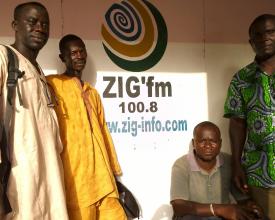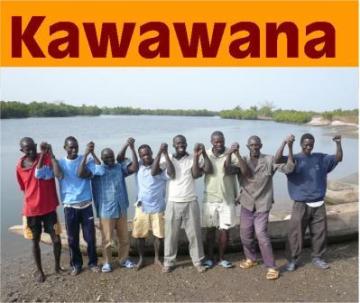Kawawana community heritage area: good life recovered through conservation
Full Solution
The Governing Board of APCRM (Association des Pêcheurs de la Communauté Rurale de Mangagoulack) in 2009.
ICCA Consortium
Kawawana (“our local heritage to be preserved by us all”) is an estuarine territory where the ancient governance and management rules –renovated and agreed upon also by the municipal and regional governments – are finally again respected. With not a cent of outside support, the local fishermen govern, manage and provide much needed surveillance operations for their own Kawawana, which has dramatically recovered in quantity and quality of biodiversity (fish, dolphins, crocodiles, birds…).
Last update: 30 Sep 2020
6557 Views
Context
Challenges addressed
Pressures on coastal marine resources, Poor food quality and security, Poor governance.
At the dawn of the new millennium, uncontrolled fishery and ecosystem exploitation in the Rural Municipality of Mangagoulak (Casamance, Senegal) have basically depleted both livelihood resources and biodiversity.
Location
Senegal
West and Central Africa
Process
Summary of the process
Only available in French. To read this section in French, please download the document "Blue Solution Template in French: ‘L’aire du patrimoine communautaire KAWAWANA: La bonne vie retrouvée par la conservation’” from the bottom of this page, under 'Resources'.
Building Blocks
Community organization
The ICCA was created by the community itself, through the association of fishermen from the rural community of Mangagoulack (APCRM).
Enabling factors
Only available in French. To read this section in French, please download the document "Blue Solution Template in French: ‘L’aire du patrimoine communautaire KAWAWANA: La bonne vie retrouvée par la conservation’” from the bottom of this page, under 'Resources'.
Lesson learned
Only available in French. To read this section in French, please download the document "Blue Solution Template in French: ‘L’aire du patrimoine communautaire KAWAWANA: La bonne vie retrouvée par la conservation’” from the bottom of this page, under 'Resources'.
Resources
Rehabilitation and strengthening of traditional rules
Assertion of community collective rights and capacity to govern (decide and implement decisions) and manage (provide surveillance, monitor) its heritage territory Re-establishment of ancient rules (for instance, no entry in the zones where the spirits live).
Enabling factors
Only available in French. To read this section in French, please download the document "Blue Solution Template in French: ‘L’aire du patrimoine communautaire KAWAWANA: La bonne vie retrouvée par la conservation’” from the bottom of this page, under 'Resources'.
Lesson learned
Only available in French. To read this section in French, please download the document "Blue Solution Template in French: ‘L’aire du patrimoine communautaire KAWAWANA: La bonne vie retrouvée par la conservation’” from the bottom of this page, under 'Resources'.
Broad discussion of the community rules with the community
Strong communication efforts (exchanges, meetings, popular debates, interactive radio in local languages) throughout the process of establishing and operating Kawawana. This has given fruits, as today other community conserved areas have been created close to Kawawana and more are in progress. .
Enabling factors
Only available in French. To read this section in French, please download the document "Blue Solution Template in French: ‘L’aire du patrimoine communautaire KAWAWANA: La bonne vie retrouvée par la conservation’” from the bottom of this page, under 'Resources'.
Lesson learned
Only available in French. To read this section in French, please download the document "Blue Solution Template in French: ‘L’aire du patrimoine communautaire KAWAWANA: La bonne vie retrouvée par la conservation’” from the bottom of this page, under 'Resources'.
Declaration of an Indigenous Community Conserved Area (ICCA)
The Fishermen Association of the Rural Municipality of Mangagoulack (Casamance, Senegal) was informed that— following international CBD decisions and IUCN recommendations— Senegal was promoting and respecting locally established “community conserved areas”. The association thus mobilized the community to create Kawawana ¬ (“our local heritage to be preserved by us all”) in its ancien estuarine territory. In Kawawana, the ancient governance and management rules– renovated and agreed upon also by the municipal and regional governments – are finally again respected.
Enabling factors
Only available in French. To read this section in French, please download the document "Blue Solution Template in French: ‘L’aire du patrimoine communautaire KAWAWANA: La bonne vie retrouvée par la conservation’” from the bottom of this page, under 'Resources'.
Lesson learned
Only available in French. To read this section in French, please download the document "Blue Solution Template in French: ‘L’aire du patrimoine communautaire KAWAWANA: La bonne vie retrouvée par la conservation’” from the bottom of this page, under 'Resources'.
Monitoring of the comeback of the "good life"
From the beginning of creation of the ICCA, the local community engaged in the monitoring of quality and quantity of fish catch, socio-economic change and ecosystem health.
Enabling factors
Only available in French. To read this section in French, please download the document "Blue Solution Template in French: ‘L’aire du patrimoine communautaire KAWAWANA: La bonne vie retrouvée par la conservation’” from the bottom of this page, under 'Resources'.
Lesson learned
Only available in French. To read this section in French, please download the document "Blue Solution Template in French: ‘L’aire du patrimoine communautaire KAWAWANA: La bonne vie retrouvée par la conservation’” from the bottom of this page, under 'Resources'.
Impacts
The “good life” is back in the villages: fish are available in good quality and quantity to households at an affordable price. The ingenious three zone management plan has fostered local food sovereignty (better diet and prosperity) and in part reversed the urban exodus. The practice of collective governance has consolidated local solidarity. The community has learned sophisticated methodologies and regularly monitors fishery and socio-economic results. Local interactive radio programmes allow to dialogue with all who need to know and respect the rules. Traditional anti-salt dikes were restored, allowing for the recovery of land for rice cultivation. The environment (spaces, species, ecosystems) has recovered and now better play its role as an ecosystem services provider. Local conflicts have diminished and attempts to exploit resources, which presented potential sources of conflict, were kept under control. For example, the burning of the Mangagoulack forest was avoided thanks to the influence of the initiators of the Kawawana ICCA, supported by the entire population of the 8 villages.
In Senegal, 6 ICCAs are currently being set up and seeking legal recognition, following the example of Kawawana.
Beneficiaries
The rural community of Mangagoulack includes 8 main villages, with a total estimated population of about 12,000 people of the Diola ethnic group.
Story
Only available in French. To read this section in French, please download the document "Blue Solution Template in French: ‘L’aire du patrimoine communautaire KAWAWANA: La bonne vie retrouvée par la conservation’” from the bottom of this page, under 'Resources'.
Connect with contributors
Other contributors
Salatou Sambou
APCRM (Association des pêcheurs de la Communauté rurale de Mangagoulack)


